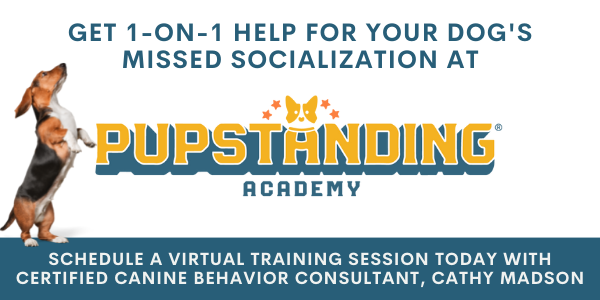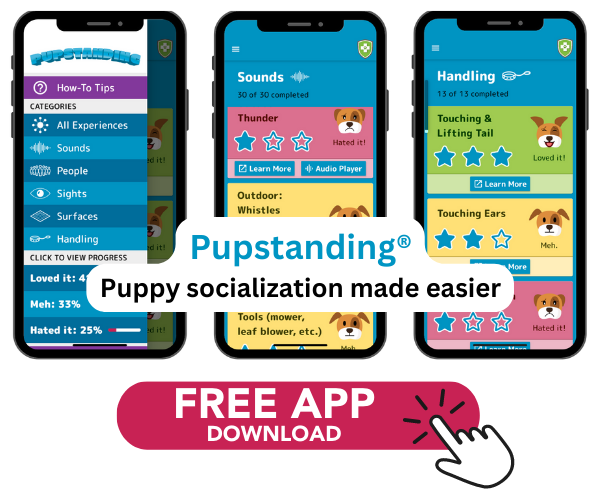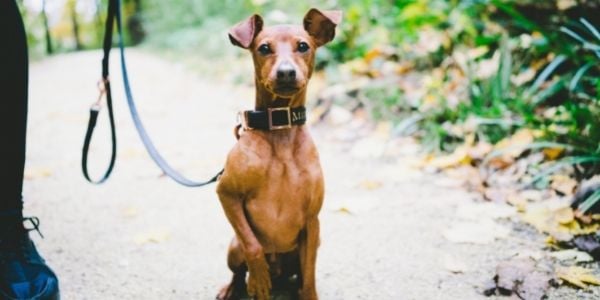
Early socialization is crucial for puppy development, but a dog may have missed out on different aspects of puppyhood socialization and training for a variety of reasons.
If a puppy gets sick, such as with giardia or kennel cough, they must avoid contact with other dogs and stay home to recover for a few weeks. This means they miss out on classes and playtime. Other puppies live in rural areas with their families or don't have access to puppy playgroups and other socialization opportunities.
Adopted dogs often have unknown histories or come from difficult backgrounds. And navigating a puppy’s socialization prior to completing puppy vaccinations can be confusing for many owners, especially when advised to not take them out and about until all their shots are completed (there are many ways to safely socialize a puppy – such as using a backpack to stroll around town or enrolling in puppy class – before all their vaccinations are complete).
The good news is that all hope is not lost! No matter the reason your dog is unsocialized or under socialized, you can still do quite a lot to help them feel more comfortable and confident.
Common Dog Behavioral Issues Resulting from Missed Socialization
If you have a dog who missed early socialization, you do have your work cut out for you. But helping your dog become more confident is an incredibly rewarding journey. Missing proactive exposure training during the critical “socialization window” (i.e., before 16-20 weeks of age – see the chart below for more info) often results in a dog who exhibits fearful, anxious, over-excited, or aggressive behavior.
Dogs who lack early socialization might be reactive towards other dogs, or fearful around unfamiliar people. Some dogs who missed early socialization don’t do well with handling, such as at the groomer or veterinarian’s office. Your dog may even be anxious anywhere outside of their comfort zone at home or have noise anxiety during fireworks.
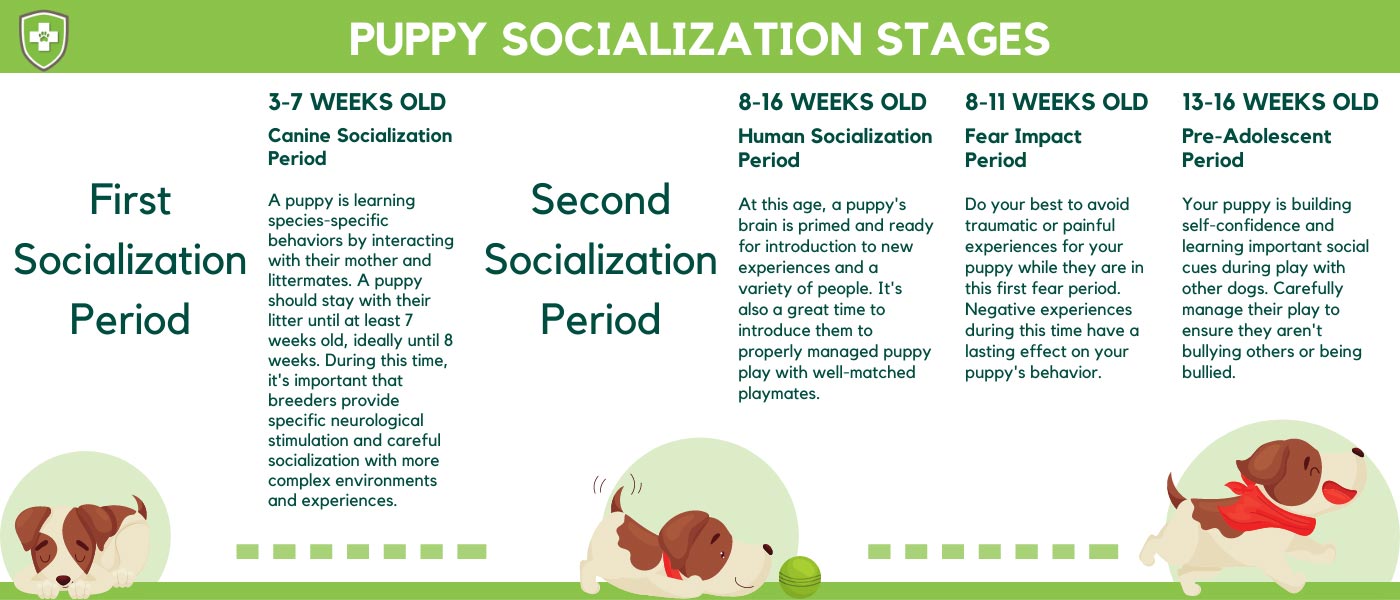
Even with proper socialization during puppyhood, some dogs will exhibit these behavior challenges later in life. While socialization during the imprint period is crucial, missing socialization or being under-socialized during this time isn’t the only cause of behavior problems in adult dogs. Genetics plays a large role in a dog’s temperament and behavior, and it’s also natural for dogs to become less social as they mature (just like us humans!). And it's always important to rule out possible medical reasons for "crabby" or aggressive behavior.
Don’t blame yourself if your dog missed out on socialization when they were young. Focus on working with the dog in front of you as they are now.
Tips for Helping an Unsocialized Dog
- Connect with a certified professional. A certified canine behavior consultant, like myself, or a board-certified veterinary behaviorist will help you work through remedial socialization safely and effectively provide much-needed support.
- Work at your dog’s pace, whatever that may be. Don’t force it. By "flooding" a dog with too much, too fast, you can increase fear and aggression.
- Keep practicing social distancing with your dog! The COVID-19 pandemic gave us some good practice in keeping our distance. For dogs who get overwhelmed or fearful around certain "triggers" in their environment, staying at a distance where they can see the trigger, but not overreact to it is important.
- Be aware that your dog may not reach the level of socialization you envision – and that’s totally okay! Many dogs who struggle with missed socialization enjoy happy and enriched lives without visiting places like the dog park, dog daycare, or local café.
- Keep the end goals in mind. The first goal is to help your dog become more comfortable, less stressed and anxious, and safer in their everyday life. The second goal is to make your life with your dog as easy and low-stress as possible.
- Identify and use the reinforcement that matters most to your dog, but that isn't so distracting to take their mind off their environment. These are most often high-value food treats, but some dogs prefer playing with toys or calm praise and soothing petting.
 Set Realistic Expectations
Set Realistic Expectations
You most likely will not have a dog that will be as comfortable around and accepting of all the people, animals, sights, sounds, and other things as they otherwise would have. That’s okay!
You may envision a dog that trainers refer to as “unicorn dogs.” These dogs are highly sociable, happy to interact with other dogs and all different kinds of people. Joyously romping into the veterinarian’s office and handling getting examined or relaxing easily under the table while their owner visits with friends outside a coffee shop. These unicorn dogs are not most dogs! But we see them everywhere because they can go everywhere.
Most dogs don’t love everything and everybody, and they shouldn’t have to. But the goal should be that your dog can be comfortable enough to feel safe and handle experiences that will need to happen throughout their life, such as veterinary visits, grooming, seeing other dogs while on leashed walks, or hearing fireworks on the Fourth of July.
Some examples of realistic expectations for your unsocialized dog:
- Being able to play with one or two well-matched dog friends for playdates (rather than expecting your dog to enjoy going to the dog park)
- Cooperative care behaviors that allow their veterinarian to examine them and provide treatment (rather than having to restrain them during the appointment or have them take anti-anxiety medications prior)
- Staying calm and focused on you rather than barking at other dogs or people while on walks (rather than expecting them to tolerate close-up interactions)
- Being able to cuddle with you during loud noise events (rather than panic and try to escape or become destructive)
Having realistic expectations helps prevent you from becoming frustrated with or resenting your dog. You may not wind up with a social butterfly, but if your dog can be happy and functional, that’s a win!
Prioritize What Socialization You Focus On!
Make a list of things that cause your dog stress, anxiety, or overexcitement. Then rank these things in the order of what is most important when it comes to you and your dog’s safety and quality of life. This is where having a professional on your team comes in handy.
You may prioritize being able to walk around the block with your dog without leash reactivity or fear, but there are ways to put that on the back burner while you help your dog get more comfortable being handled at the veterinarian. Your behavior consultant may recommend substituting walks with backyard play and other enrichment activities, so you only need to focus on handling exercises.
As you and your dog progress with the first item on your list, you can then add more experiences into your training practice. Don’t overwhelm you and your dog with too much at once! It’s easier to stick with one thing at a time rather than trying to do it all and end up getting nothing done.
Start Small When Socializing Your Adult Dog
Is your dog comfortable in your backyard, but freezes and gets tense anytime you take them in the front yard? Start with that! Stick with the backyard at first and work on confidence-building exercises. Create a foundation of easy cues, such as name recognition and touch, to give you and your dog easy ways to connect.
Once you have built a solid foundation and increased trust, then the next step is to expand those areas slowly and systematically. Don’t make the mistake of trying to get your dog comfortable with the whole wide world or “all the things” at once. Think baby steps and build upon successive wins.
If you’re unsure of what to start with, download our free Pupstanding Socialization App. The Pupstanding app was created as an interactive checklist for puppy socialization and lists a variety of people, sights, sounds, and objects that you can use as goals for you to try to get your dog comfortable with. Just recognize that you may not ever get through the full list — but it's a good place to start for remedial socialization later in life. It will help you keep track of all the things your dog is and isn't comfortable with, giving you a plan for what to continue working on.
Slow and Steady
Patience is a virtue. When it comes to trying to help a previously under- or unsocialized dog, this is especially true! Pay attention to your dog’s comfort level and proceed at a pace that works for them. Learning to read your dog’s body language is especially important to gauge their comfort level in different environments.
You want to manage the distance and intensity level of their exposure to things they are unsure about. Being able to see the small changes in their posture or subtle signs of stress (such as lip licks and paw lifts) means you can move away from or reduce the intensity of their “trigger” – the thing that is causing them stress. The goal here is to keep your dog under threshold and begin to pair positive things with the presence of their trigger, a process called counter conditioning. I’ll explain both counter conditioning and thresholds further below.
Don’t put an artificial timeline on your progress and don’t put too much pressure on your dog (or yourself). With the right guidance and plenty of patience and understanding, your dog will get there … wherever “there” happens to be for your dog (see above re: setting realistic expectations). If you want to learn more about dog body language, I've put together some great resources.
Counter Conditioning for Remedial Dog Socialization
The process of counter conditioning is how we change a dog’s negative emotional response to something to an emotional response that’s positive, or at the very least neutral. We do this using primarily classical conditioning (does Pavlov ring a bell?). Presence of your dog’s trigger = something good happening.
Below I’ll briefly talk about how to begin counter conditioning, but it’s extremely important to have the help and support of a certified professional during this process. Without professional help, it's easy to rush through this process and miss important communication from your dog that they are stressed.
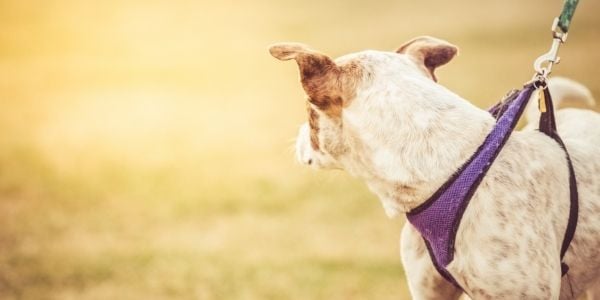
Identify Your Dog’s High-Value Reinforcers
Find out what your dog really loves and use that to your advantage. Is your dog food motivated? What are some of their most favorite treats? Those would be their “highest value” food rewards. For most counter conditioning, food is the easiest and most effective. But for some dogs, especially those that are overexcited, toys and play may be of higher value than food in those moments.
Whatever rewards and reinforcers you use, you do want to make sure that they're not so distracting as to take their mind completely off their surroundings. Your dog does need to be aware of their surroundings, to some degree, to become more comfortable with them. Learn how to identify your dog's high-value treats in What Kind of Treats Should You Use in Dog Training?
Identify Your Dog’s Threshold
This is far enough away (or at a low enough intensity level for things like sounds or touch) that your dog doesn’t feel overwhelmed or flooded with anxiety, but close enough that they at least notice the trigger. Your dog’s brain needs to be under threshold to make associations with the world around them. If they are over threshold, meaning that their brains are in more of a “fight or flight” mode, they cannot learn.
Signs that your dog is over threshold include:
-
Frozen or “shut down”
-
Not taking treats when otherwise they normally would
-
Growling and/or barking
-
Lunging and/or air snapping
-
Trying to run away and escape
Establish a baseline “just below” threshold level for your dog to begin counter conditioning. Some examples may be:
- 50 feet from other dogs while on a leashed walk
- Sound of fireworks at volume 4 of 10 on your phone (you can use our socialization app for this)
- Showing your dog the nail trimmers (but not touching their paw with them)
Your dog’s threshold may change day-to-day, so don’t be surprised or get discouraged if something they could previously handle the day before is too intense for them the next day. Just work further away or take a day off from counter conditioning practice.
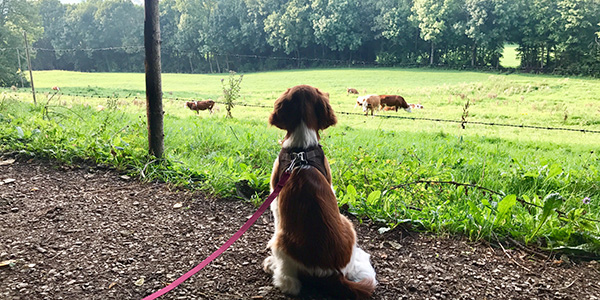 Pair Your Dog’s Trigger with Something Positive ... Over and Over Again
Pair Your Dog’s Trigger with Something Positive ... Over and Over Again
Whenever your dog’s trigger appears, pair it with something positive that they love.
- A dog appears down the block = treats fall from the sky!
- You touch their nail with the clippers (but don’t clip yet) = treats fall from the sky!
- Firework sounds are playing = treats fall from the sky!
- A jogger passes you by = treats fall from the sky!
Timing is important here. The thing your dog is unsure or scared of needs to predict the good thing happening. Do not give your dog the treat (or whatever reinforcer you are using) until after their trigger appears. Doing so can result in a poisoned reinforcer, where you grabbing a treat predicts something they don’t like happening and increase your dog’s hyperawareness and reactivity. That’s the opposite of what we want.
With continued practice, your dog’s emotional response to seeing their trigger from their just-under-threshold distance changes from a negative to a positive. It takes repetition, so stick with it! What we also see is that we’re able to get closer to the trigger or increase its intensity in a systematic approach. You don’t want to jump from working 50 feet from another dog to suddenly 5 feet away. That’s a recipe for your dog to become overwhelmed and go over threshold. Instead, over time we systematically decrease the distance or increase the intensity.
Keep Your Eye on the Prize
There will be setbacks and plateaus in your dog’s progress. Rome wasn’t built in a day. Don’t get frustrated or give up. Take a breath and reevaluate your approach.
You might need to add distance or decrease the intensity of the trigger. Maybe increase the “value” of the rewards you’re providing. Perhaps you and your dog need a couple of days off from intentional counter conditioning practice. Talk with your trainer or behavior consultant about what may need to be tweaked. You’re doing this work for the long-term benefit of both you and your dog. Some short-term setbacks shouldn’t derail your long-term goals.
Watch Coconut's amazing change from nervous "puppy mill" pup to loving life as a rescued dog.

You Need Not — And Should Not — Go It Alone
The video above emphasizes the point I make in every section of this article — get help! Working with a dog that has missed their early life socialization can be a daunting task, even if you’ve previously had and helped such dogs before. Every dog and every situation is different.
Set yourself up for success by getting professional help early on, as you really want to do everything possible to start off this journey on the right foot. An experienced and good trainer can be worth their weight in gold when formulating a plan to help with delayed socialization. There are also board-certified veterinary behaviorists that can help a ton, especially if anti-anxiety medications are indicated (which they very often are, at least in the short term).
Choosing a Dog Trainer to Help
All dog trainers are not the same, and neither are training methods. Even with “normal” dogs and in normal situations, dominance- or correction-based training methods are not a good option. But this is even more so the case when it comes to helping previously under- or unsocialized dogs get more comfortable in the world.
These situations, even more so than “normal” situations, are not helped by dominating, forcing, or creating pain or increased anxiety in a dog. Such methods will only make matters worse. Only work with trainers whose methods are based on sound behavioral science, typically referred to as “rewards-based,” “R+,” or “force-free” trainers. You and your dog will be much happier using their services and approach. Find out what to ask a dog trainer (and what their answers should be) here.
If you need one-on-one support from a certified canine behavior consultant, check out our virtual dog training sessions. During these virtual sessions, you and I will map out a plan to help you and your dog to live a safer, happier, and better life.
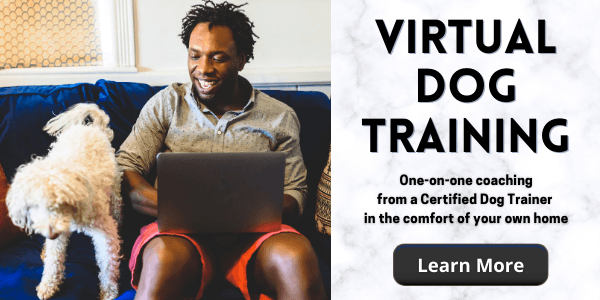
Do Unsocialized Dogs Benefit from Medication?
Dogs that are stressed, anxious, or fearful have a hard time letting their guard down and learning new things. Some dogs are so stressed that they have a difficult time ever coming below threshold and even getting to a state of mind where they can learn. The proper use of appropriate anti-anxiety medications, supplements, or other aids can help to bring these dogs below threshold, allowing them to start learning and forming better, healthier, happier associations with different things.
Your behavior consultant can help determine if this is something you should consider and may recommend talking with your veterinarian or connecting with a veterinary behaviorist early in the training process rather than waiting. This does not necessarily mean that your dog will need these medications long-term.
Sometimes it takes a combination of different medications, supplements, and other aids. Because every dog and every situation is different, there can be some trial and error and some fine-tuning needed when using behavioral medication. Engaging the help and guidance of a board-certified veterinary behaviorist as part of your support team can greatly increase your chances of success with your new dog. Doing so can also greatly decrease the setbacks and frustrations that may be encountered along the way.
You can search for a board-certified veterinary behaviorist or ask your behavior consultant or veterinarian for a referral. Veterinary behaviorists are unfortunately few and far between — however, even if there isn't one near you, many provide telehealth options or can consult directly with your dog's veterinarian.
Things to Avoid with an Unsocialized Dog
Dog Daycare
Doggy daycares are not always ideal for remedial socialization. They are best for dogs who are already socialized and do well in these environments (like those unicorn dogs I talked about before). While it may sound like a good idea to “try it out and see how they do,” overwhelming or flooding a dog who already feels unsure usually backfires and increases their anxiety in those situations.
All dog daycares are not equal – some may have a good setup and management in place for dogs who need some time to get more comfortable. Go in with your eyes open and ask lots of questions, and don’t get discouraged if the daycare staff inform you that their facility is just too much for your pup. Click here for more tips and what questions to ask when choosing a dog daycare.
Dog Parks
In all honesty, I’m not a huge fan of dog parks. They can be great for some dogs (unicorn dogs!) but can be traumatizing and dangerous for unsocialized dogs or puppies still in their socialization period. If your dog missed early socialization, do not take them to a dog park and hope for the best. Your behavior consultant can help you determine how and when this activity may be appropriate.

Overwhelming Experiences & Environments
When you are unable to actively counter condition your dog and manage their environment to prevent them from going over threshold, it's best to have them safely confined in their safe space. For example, if your dog doesn't do well around children and family or friends with children are coming to visit. Or if you're going to an outdoor event where there might be crowds or lots of other dogs, simply leave your dog at home with a stuffed Toppl or interactive toy to work on. There is nothing wrong with not bringing your dog along if you know it may be difficult for them to stay calm. This way you can enjoy yourself and your dog can relax.
Dogs who become overwhelmed out and about or don't do well with other dogs or unfamiliar people can live very fulfilled and happy lives without being places in these situations. Making sure your dog has lots of mental enrichment, exercise, and a strong relationship with you can help them maintain a high quality of life without forced socialization that causes them unneeded stress and anxiety.


